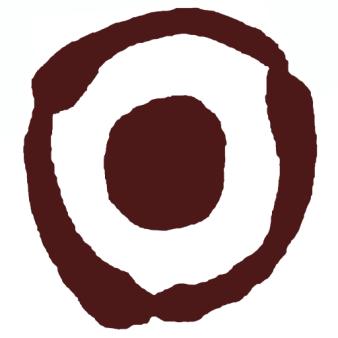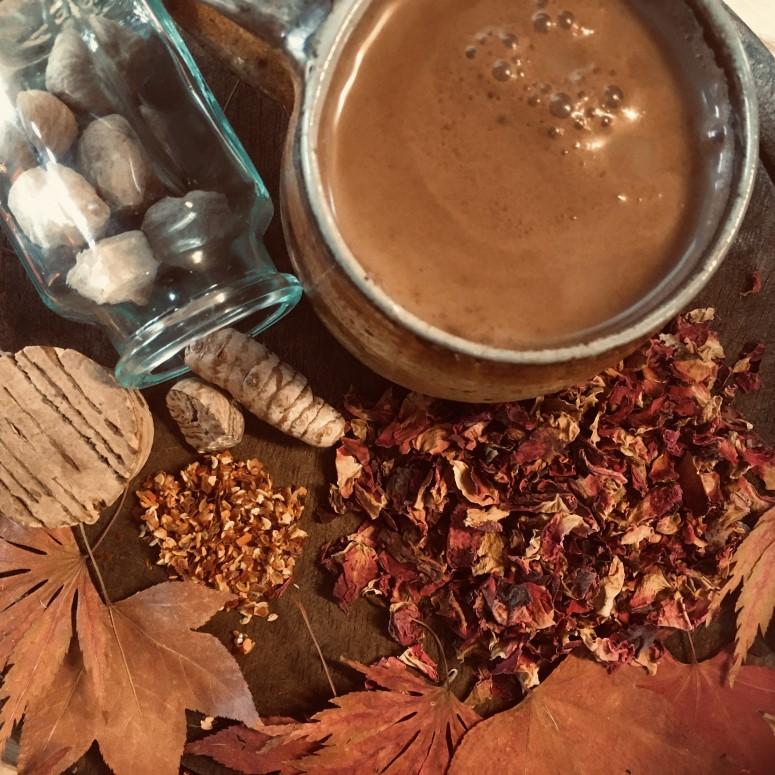
9 minute read
vii Notes from the Brew Room Ann King
Fire Cider Packs a Herbal Punch Ann King
As the nights are getting longer, we are encouraged to slow down and stoke up both the home and the internal fires. If, like me, you crave stodgy comfort food and sweet things at this time of year, the winter months can prove difficult for the digestive system. As we all know, if the gut is not happy, our general wellbeing may suffer. So, the following recipe focuses on herbs that are warming and beneficial digestives, with some antimicrobial action to address any pathogens that may be lurking. This is a personal favourite, based on the many traditional folk remedies, which all aim to ward off colds and flu and generate heat. It features Ginger, Turmeric and Horseradish roots, Black Pepper, Onion, Garlic, Cayenne Pepper, Thyme, Lemon, Apple Cider Vinegar and local Honey. The following fills a one litre jar.
Advertisement
Ingredients Ginger (Zingiber officinale) 5cm, finely chopped —a powerful herb, useful for times of nausea or stagnant digestion. Black Pepper (Piper nigrum) 10 peppercorns —another warming herb, which acts by stimulating stagnant circulation and digestion. Furthermore, it increases the bioavailability of partner herbs in a formula, encouraging the uptake of nutrients. It isn’t just a seasoning, after all. Turmeric (Curcuma longa) 3cm, freshly grated — helps decrease inflammation and improve poor digestion. Horseradish (Armoracia rusticana) 3cm, freshly grated —to improve upper respiratory tract health. Cayenne Pepper (Capsicum annuum) 1, finely chopped —for fever, circulation and headaches. Onion (Allium cepa) 1, finely chopped —to stimulate the appetite and ease congestion. Garlic (Allium sativum) 1 bulb, minced —a strong antimicrobial and immune system ally. Thyme (Thymus vulgaris) 2tbsp, dried —to soothe coughs, congestion and infection. Lemon (Citrus limon) ½, chopped —a powerful source of vitamin C, and for natural flavouring Honey. Enough to cover the herbs —a medicine chest on its own, it will add depth and sweetness to counterbalance the pungency and potency of the other flavours. Apple Cider Vinegar. Enough to top up the jar
Method Simply add all the herbs to the jar, pour Honey to cover and top up with the Apple Cider Vinegar. The mix should be shaken daily for a month, then strained and poured into a sterilized bottle. Consume either neat off the spoon, or mixed with warm water as a longer drink.
To Dye For… Elizabeth Oliver
The garden is changing gear for winter, literally slowing down— and changing colour. Last night, we had the first ground frost, and today the soft leaves of many plants are drooping and looking rather sad.
This cold snap, whilst entirely expected in November, has successfully stopped my last autumn job— making contact prints on fabric. I’m not talking about dyeing a piece of cloth in a dye bath made of leaves or bark or berries, I’m talking about extracting colour from plant matter to make marks on fabric. The leafshaped marks are permanent memories, using enzymes and pigments inside the plants themselves. Collecting plantstuff and laying it out on pre-mordanted fabric, then wrapping the bundles around a stick and securing with ‘tee-shirt string’ is a great pastime. There are some general principles concerning the type of fabric and how it is to be prepared but, essentially, contact printing or ‘bundling’ is the closest thing to magic in a garden!
Let’s talk about the fabric. It must be a natural fibre— either from plants (linen or cotton), or animals (so called ‘protein’ fibres like wool, silk or alpaca). We mordant the cloth to stop the plant colour from washing out, and to make it light fast (i.e. to prevent it fading unduly). Over the years I have tried many mordant recipes, including soaking in soya milk, alum with cream of tartar, alum with iron, and alum with soda ash. The internet is full of different methods, and none of them are ‘the best’. Just remember that, for generations, people have been successfully putting colour onto cloth they have woven. Once fabric or yarn has been properly scoured (cleaned) and mordanted, the chemical makeup is changed and fibres become receptive to dye. That ‘greedy’ quality sticks, so that— even after washing —yarn and fabric will take on colour from a second, or even third dyebath.
But this piece is not about dyeing in a dye bath, it’s a celebration of the lovely marks that miraculously appear on bundled cloth, helping me to hang on to my summer garden. So, having made your bundle of cloth wrapped round a stick and tightly bound with string— the last bit is important, because the process relies on the plant matter being in close contact with the fabric —now you are ready to steam or cook the bundle. It might take 30-90 minutes for the marks to transfer onto the cloth, but once made, they will not wash out. Carefully remove your bundles from the cooking pot and, once cool, unwrap them to remove the spent leaves, and see your lovely patterns. I then wash the cloth in soapy water and, after rinsing and drying, give it a hot iron, which seems to set or ‘finish‘ the process.
Images: Elizabeth Oliver



Circles and Swirls Milly Watson Brown
I love journeying with the seasons, and autumn is definitely my favourite. The colours are such a feast for the eyes. I’ve been working with the inner and outer seasons for many years now. My passion for food, which has been a large part of my life and work, and my love for foraging and herbal alchemy, alongside menstrual cycle awareness and womb health, brought me to create Moon Time Chocolates— chocolates infused with herbs to support the menstrual cycle. The journey has opened me to the subtleties within us, and that which is expected of us in the world.
Energy seems to be a hot topic in modern society. We are expected to have the energy to be constantly and consistently productive, alert and giving, and if we don’t have that energy, we ’re encouraged to fake it with stimulants such as coffee, tea, energy drinks, sugar— giving ourselves, and others, the impression that we are ready for anything, anytime! This, to me, is a very masculine-yang-linear approach. What would happen if we listened deeper; listened to the more feminine-yincircular qualities within us?
Every gender exhibits masculine and feminine qualities, so it’s not about gender-specific tasks, it’s about listening. Our society doesn’t give much space, or permission, to listen to our own needs. Just imagine what would happen if we did. What if, say, people who menstruate were able to have one day off every month with their period? A day to dream, nurture and rest. I haven’t met many who wouldn’t appreciate and benefit from this. It would allow us the space to connect to our deeper intuition and, from my experience, would give us more vital energy for the following month. One day of rest then, as the rise in energy of ovulation comes, productivity increases without force or stimulants, easily making up for that day. As it stands, ovulation-level productivity is what society is asking of us all the time.
For those who don’t have monthly cycles, or who wish to understand these patterns more, simply contemplate the four seasons of the year, or connecting with the moon’s phases: Winter. Dark moon. Days are shorter. You want to rest more under the duvet, slow down, eat warming foods, stay in, have early nights. This is similar to the energy of menstruation. Spring. Waxing moon. Days are lengthening, energy is rising. You feel inspired and energised, busy, adventurous, and playful. This is similar to pre-ovulation in the menstrual cycle. Summer. Full moon. Days are long, nights are short. You are utilising the daylight and getting lots done, socialising and being productive and creative. This is similar to ovulation in the menstrual cycle. Autumn. Waning moon. Days are shortening, it’s harvest time. Gathering fruits of the year, winding down, getting supplies in ready for winter and the beginning of hibernation. This is similar to the premenstrual phase.
I know that many people struggle to adjust to the inner and outer seasons, and this is why it’s important to take the time to listen to your changing needs. How about allowing yourself to take that deep breath, to pause before saying ‘yes’ to everything? Try saying ‘I’ll let

you know later’, and give yourself time to check in with what you really need. We’re all familiar with our people-pleasing socialization, but why not risk letting someone down? You might even inspire them! Working with the inner and outer seasons has taught me to love listening for what needs to be nurtured within me. As Autumn draws to its depths, and winter taps on the door, it’s time to cosy up with a mug of cocoa. This rich, velvety, dark drink— in my humble opinion —settles all sorts of ails. The gorgeous Cacao (Theobroma cacao), available in raw or roasted form, offers subtly different qualities to our energy.
Raw, unroasted Cacao is high in antioxidants, and minerals such as magnesium, iron and zinc. The simple joy of consuming it gives you that feel-good experience, by increasing serotonin— helping lift depression, anxiety and stress. Cacao also helps reduce tiredness and fatigue. The more common roasted cocoa has similar benefits, though it seems to lose some of the antioxidant qualities to the high temperature of the roasting process. I prefer to stick to roasted cocoa if I’m having it towards the end of the day, as raw Cacao can be much more stimulating— a bit like having coffee. You could make a hot chocolate; from cocoa powder, by grating some pure Cacao paste, or by melting your favourite chocolate bar into warm milk of your choice, whisking and sweetening to taste. Try infusing different herbs to enhance the effects of the Cacao and to balance, complement or enhance the different phases of the menstrual/moon cycle. It’s a joy to add secret ingredients to your hot chocolate. What about a warming, spiced Cacao? Simply add tiny amounts of chilli, ginger and nutmeg. If you ’ re drinking it in the evening, and wishing to open to the dream world, try infusing 1tsp of dried Mugwort (Artemisia vulgaris) in a mug of warm milk for 15 minutes before straining, rewarming and adding a heaped teaspoon of cocoa powder. My all-time favourite is a flask of Rose (Rosa spp.) and cocoa. The Rose enhances the heart-opening properties of the cocoa. It’ s similar to make, just set 1tsp of dried Rose petals to infuse in the warming milk…I’ ve also enjoyed Rose brandy tincture in my hot chocolate. It’s divine.
I have tried making seaweed chocolate and wouldn't recommend it, so I can't make a link to this issue's herb, but let’s see what ally we can experiment with next month…
@moontimechocolate www.moontimechocolate.co.uk Images: Milly Watson Brown
51 Marianne Hazlewood
Arisaema griffithii
Ink Shoots series











